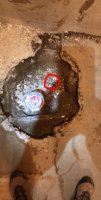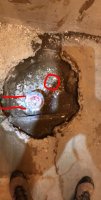Shaun Monaghan
New Member
Hey all!
So I’m trying to remodel a downstairs bathroom in a recently purchase house. The way they had the old toilet oriented there was basically no room to actually sit on the toilet. So I’m trying to rotate the toilet 90 degrees to the back wall.
I’ve broken out the concrete to get access to the pipe and it looks like it’s cast iron as it’s a 1955 Home. I think if I frame up the back wall to run the water through I will need to move the pipe about 3 inches over to make the 12 inch run in from the new framing. (Or 2.5 inches if it’s from the dry wall.)
Hope that makes sense. This is my first attempt at a project like this and would love some extra brain power on how to achieve this. Do I have to cut the pipe down to add elbows so i can move it over? Or is there another option.
So I’m trying to remodel a downstairs bathroom in a recently purchase house. The way they had the old toilet oriented there was basically no room to actually sit on the toilet. So I’m trying to rotate the toilet 90 degrees to the back wall.
I’ve broken out the concrete to get access to the pipe and it looks like it’s cast iron as it’s a 1955 Home. I think if I frame up the back wall to run the water through I will need to move the pipe about 3 inches over to make the 12 inch run in from the new framing. (Or 2.5 inches if it’s from the dry wall.)
Hope that makes sense. This is my first attempt at a project like this and would love some extra brain power on how to achieve this. Do I have to cut the pipe down to add elbows so i can move it over? Or is there another option.
Attachments
-
 209942EE-2279-480A-A63D-18E651F7CF45.jpeg70.1 KB · Views: 316
209942EE-2279-480A-A63D-18E651F7CF45.jpeg70.1 KB · Views: 316 -
 D3766E18-0B56-4037-9702-61B297BF353B.jpeg65.4 KB · Views: 555
D3766E18-0B56-4037-9702-61B297BF353B.jpeg65.4 KB · Views: 555 -
 96C3CA3D-343B-474D-80AD-3C4FBCA33DC1.jpeg78.7 KB · Views: 366
96C3CA3D-343B-474D-80AD-3C4FBCA33DC1.jpeg78.7 KB · Views: 366 -
 8B43A96D-327E-4ED8-B369-8A1699E765FC.jpeg54.5 KB · Views: 320
8B43A96D-327E-4ED8-B369-8A1699E765FC.jpeg54.5 KB · Views: 320 -
 8004B900-A075-404B-800A-940A2C8A9E61.jpeg68.4 KB · Views: 302
8004B900-A075-404B-800A-940A2C8A9E61.jpeg68.4 KB · Views: 302
Last edited:

